

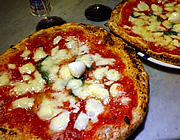
Staying in the Centro Storico in Naples we discovered perfect pizza, a fabulous Caravaggio, manic street life, underground excavations, peaceful cloisters. We returned in 2018 to the same vibrant city for more exploration.
All photographs 2017 unless otherwise stated.
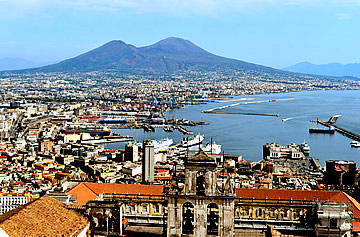
Famed for its beautiful bay, Naples is a city of many faces, ranging from Greco-Roman underground streets to bustling modern arcades.
There has been a settlement here for many centuries but the town of "Neapolis" came into being in the fifth century B.C. as a satellite of nearby Greek-settled Cumae. It was taken by the Romans in 328B.C. and it remained an uneasy Roman conquest for 800 years when the Goths and then the Byzantines invaded. The city became increasingly wealthy and independent and an attractive target for attack.
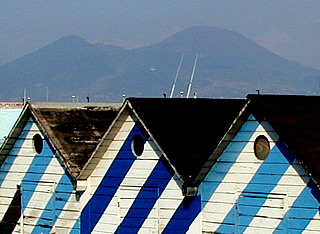
Periods of Norman, Germanic, French, Spanish and Austrian rule through the centuries eventually led to the Neapolitans voting to join Italy, newly united by Garibaldi, in 1860. Earthquakes, eruptions and cholera outbreaks have all taken their toll in the area, though Naples was largely unaffected by the huge eruption of Vesuvius in 79A.D. which buried Pompeii and Herculaneum.
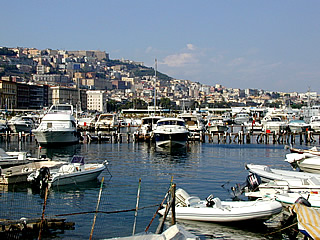
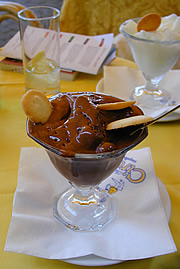
The little port of Mergellina to the west is lovely to wander around - we had excellent chocolate ice cream at Chalet Ciro.
Thirteenth century Castle Nuovo dominates the harbour where the ferries leave for the islands, herculaneum and the Sorrento peninsula.
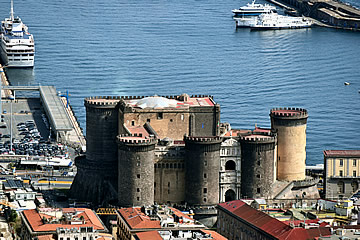
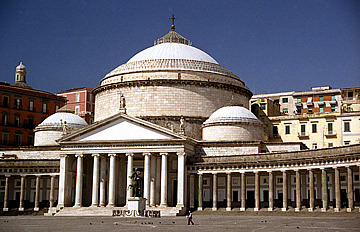
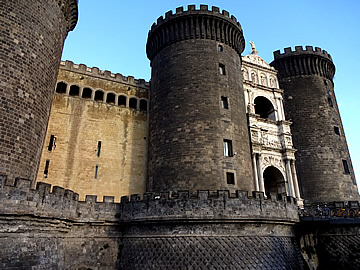
The early nineteenth century Basilica di San Francesco di Paola curves around Piazza del Plebiscito, south west of Castel Nuovo - a striking white building which stands opposite the Palazzo Reale in a traffic-free zone.
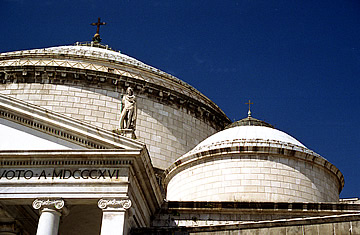
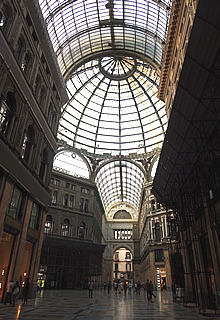
Good ice cream at Scimie just north of the piazza, though we felt the chocolate at Scimie in the Centro Storico was better. Here the feel of the city becomes much more modern with its busy stores and arcades. Galleria Umberto is one of the most impressive, though the shops didn't seem very enticing. It is very reminiscent of the Galleria Vittorio Emanuelle II in Milan.
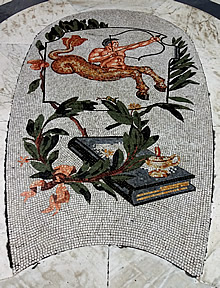
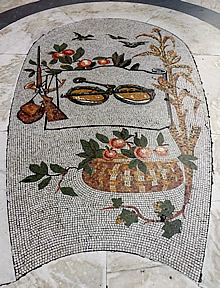
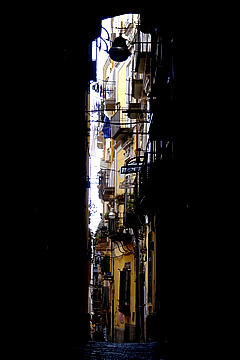
The Centro Storico is the oldest part of the city where the Roman grid plan of streets is still a marked feature. Here the tall, crowded buildings and narrow, noisy, bustling streets are quintessential Naples. Under the churches, shops and apartments lies a subterranean world.
In 2005 we stayed in the small Hotel Neapolis on via del Giudice just off Via dei Tribunali in the centre of the Centro Storico. Only a three star hotel but in a great location, much of what we wanted to see, apart from the bay, was in very easy walking distance.
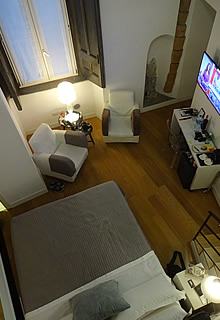
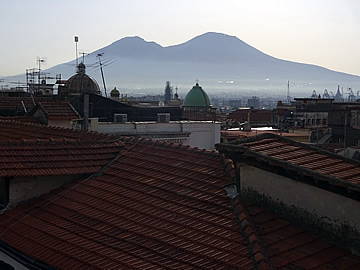
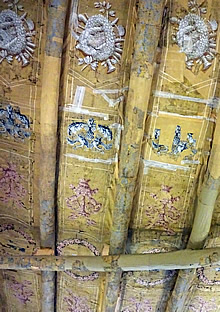
In 2017 we went up market and stayed in the lovely Hotel Santa Chiara on Via Benedetto Croce, also in the Centro Storico but rather more luxurious. It is housed in the seventeenth century Palazzo Tufarelli and still retains some of the original decoration. We had a lovely comfortable two-level room with excellent air con and the rooftop terrace of the hotel had fantastic views over the city and east to Vesuvius.
Via Benedetto Croce is the east end of what was once the decumanus inferiore of the Roman city of Napoli and is now nicknamed spaccanapoli - literally "Naples splitter"!
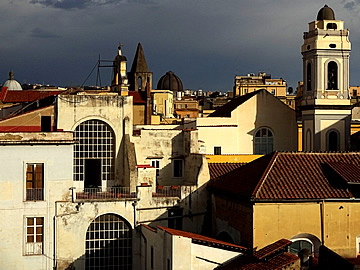
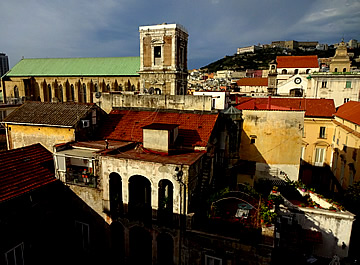

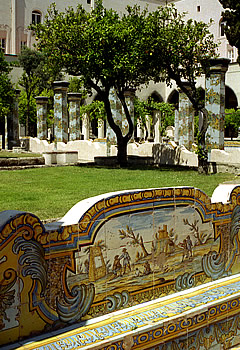
The hotel is just east of the Complessa Monumentale di Santa Chiara on the south side of Piazza del Gesù. The church was seriously damaged by bombing in the Second World War (now reconstructed), thankfully the 14th century cloisters were spared.
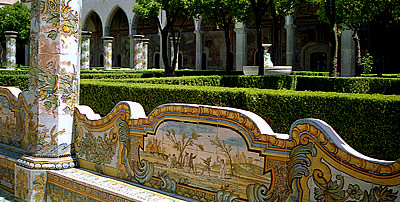
The cloisters are very beautiful, with wonderful 18th century majolica tiled seats, low walls and octagonal columns surrounding a quartered space of grass and citrus trees, an amazingly peaceful spot in the middle of the noisy, busy city.
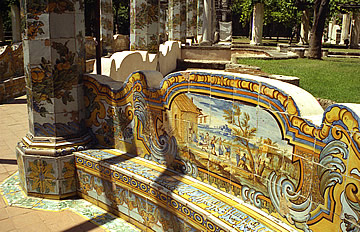
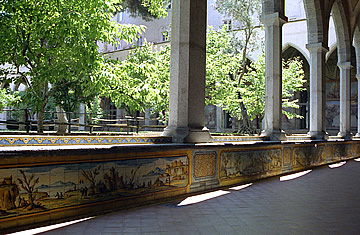

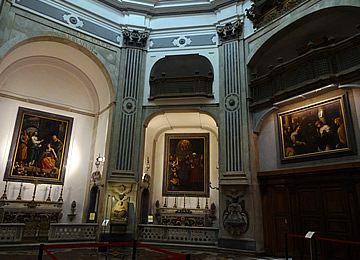
For me it was essential to see a famous painting by Caravaggio, one of my favourite artists.
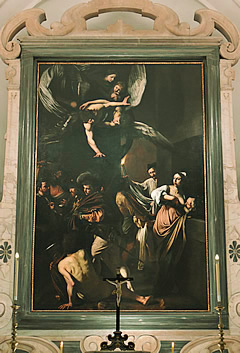
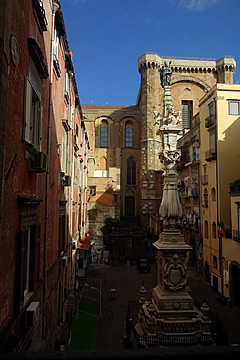
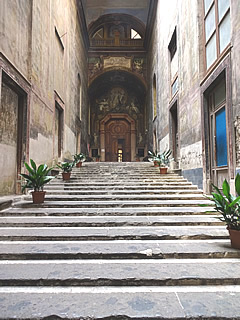
Caravaggio fled to Naples from the authorities in Rome where he had killed a man. Though he didn't stay long in Naples, he painted several important paintings, including the "Seven Acts of Mercy" which is in Pio Monte della Misericordia on via dei Tribunali in the Centro Storico. It is an amazing, complex work, commissioned as an altarpiece for the church in which it has remained for 400 years. The seven merciful acts recognised by the Catholic Church were: feeding the hungry, visiting prisoners, clothing the naked, burying the dead, caring for the sick, giving hospitality to pilgrims and providing drink for the thirsty. These are all depicted in the painting in a number of wonderfully executed integrated cameos.1 In 2017 we went again to see this wonderful painting.
In 2017 we were also able to go into the first floor gallery of the church which has a collection of art and artefacts. It is also possible to se into the main body of the church and the Caravaggio from here.
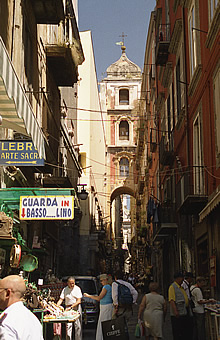
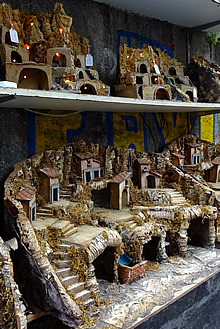
One of the more famous streets in the Centro Storico is the street of the nativity makers: Via San Gregorio Armeno. The nativity scenes and cribs (presepe) are an important part of Christmas here.
The bell tower over the street is the 17th century addition to the 8th century monastery of San Gregorio, founded by religious refugees of the Byzantine Empire. In the 11th century the monastery had already been combined with two chapels to form a Benedictine order.
To visit the monastery of San Gregorio in 2005 we had to ring a bell at the entrance gate and a nun came down to let us in. In 2017 we just walked up the steps.
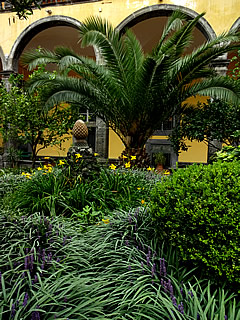
The tall umber walls of the monastery shelter the cloister gardens - a very peaceful place. All we could hear when we visited in 2005 was the chanting of school children - the noise of Naples had simply disappeared.
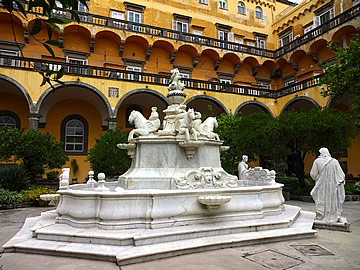
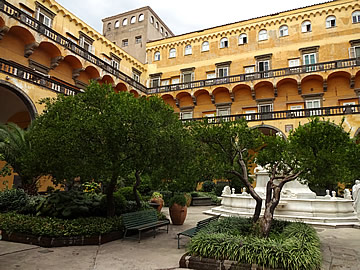
In 2017 the white-habited nuns were were very friendly, though my Italian was sadly lacking in talking to them.
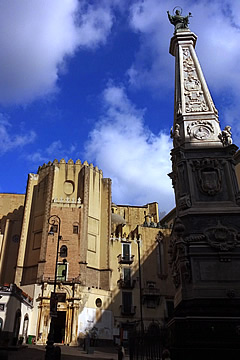
The church of Santa Anna dei Lombardi is rather a grim building (2005), the little of what remains of a monastery, but the attractions are all on the inside. When we visited it was undergoing restoration but we were shown around by one of the conservators and were able to see a beautiful carved Annunciation altar piece (Benedetto da Maiano, 1442-1497), a remarkable set of eight life-size terracotta figures of a Pieta (1492 by Guido Mazzoni), and some magnificent marquetry panelling (attributed to Giovanni da Verona and others, 1506-10) in the old refectory. We were not allowed to take photographs here.
The Museo Capella Sansevero is absolutely amazing for the eighteenth century sculptures of a Veiled Christ by Giuseppe Sanmartino, another veiled figure called Modesty by Antonio Corradini, and Disillusion by Francisco Queirolo a figure extricating himself from a net. The skill in working the transparent veils on the figures is quite amazing, and it is difficult to believe that the open work of the net draped over the figure in Disillusion was carved from a single piece of stone. The story goes that the skilled burnishers of the day refused to work on it for fear of the delicate netting breaking off in their hands - Queirolo had to burnish the piece himself.2 Sadly no photography is allowed in here either.
The chapel was the work of Prince Raimondo di Sangro who remodelled the original sixteenth century building in the eighteenth century. He seems to have been rather an unusual character, something of a scientific experimenter. This is further evidenced by two preserved skeletal bodies in the basement of the chapel, their circulatory systems intact - how this was achieved is not understood.3
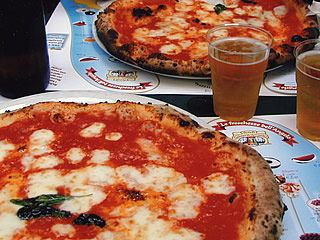
In 2005 we had very good pizza at Dell' Angelo's in the Centro Storico and at that time it was the best pizza we had. My favourite is Margherita with lots of good tomato sauce and first-rate mozzarella. This is an area where both these ingredients can be found. The best Mozzarella we have ever had was in Paestum, south of Naples - Campania is renowned for its buffalo milk mozzarella. Da Micheli's had been recommended by various sources too but, although good, we felt dell'Angelo's had the edge.
The best tomatoes for pizza, we have learned, are San Marzano tomatoes. I have grown these in Switzerland but they just don't have the great taste of those grown here - it is apparently essential that they are grown on volcanic soil.
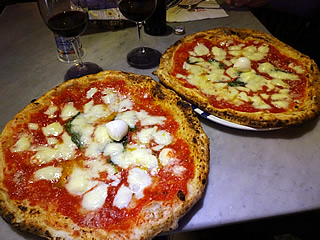
However, in 2017 we had the best pizza at Sorbillo on Via dei Tribunali - we even went back to Dell'Angelo to compare but it wasn't a patch on Sorbillo!
Sorbillo is incredibly popular with crowds outside the door and one of the waiters with a clipboard making a list. We waited maybe twenty minutes before getting a table. Definitely worth the wait. I ordered a Margherita with extra San Marzano tomato sauce and thoroughly enjoyed it. We had a glass of red wine to go with the pizzas and evne though the restaurant was packed we didn't feel rushed at all.
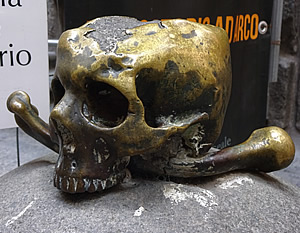
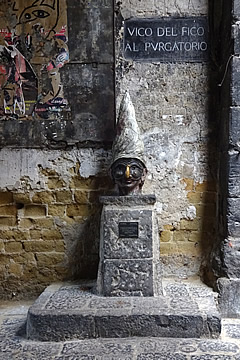
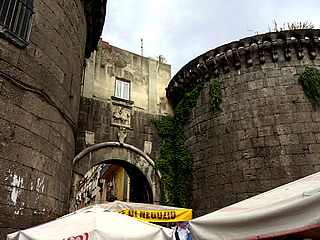
Via dei Tribunali was once the major east-west street of Roman Naples - the decumanus maximus.
In contrast the Porta Nolana was the medieval entrance to the city from the east. These days it is better known for the street market held beneath its walls. Traditionally it is a fish market but there is a wide variety of other produce for sale as well. We visited in both 2005 and 2017 and it hadn't hanged much. It's very much a market for the locals
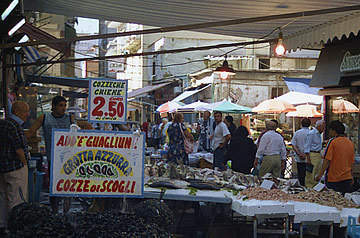
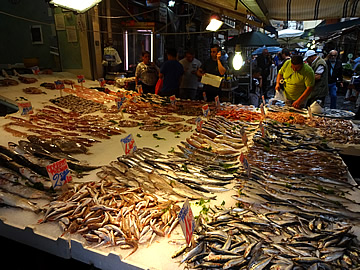
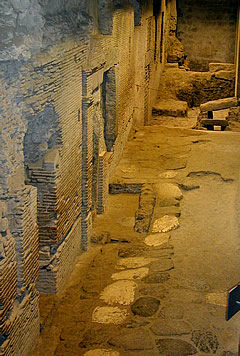

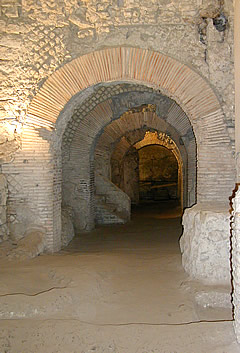
The Archaeological Site of San Lorenzo Maggiore is a fascinating glimpse into the ancient city. Deep beneath the foundations of this church in the Centro Storico lie the excavations of Greco-Roman streets. We were virtually alone down here and it was amazing to think we were actually walking on the cobbled streets of ancient Neapolis.
It's not a huge site but a large section of the first century A.D. market has been extensively uncovered, with all kinds of shops.
The main street through the market, about 54m long, connected Decumano Maggiore (which is now Via dei Tribunale at gorund level) on its northern side with Decumano Inferiore (now via San Biagio di Librai) on the south.
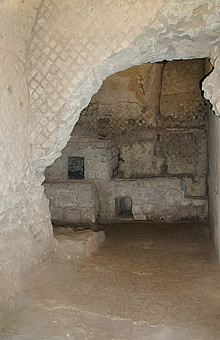
On the south side is a five chambered structure, called a Criptoportico - a covered corridor. Each chamber contains a small ceiling "skylight" and two large tufa blocks. The blocks are set either side of the central axis of the chamber and the upper surface of each block is cut to slope on one side.
The function of these intriguing spaces is unknown - guesses range from fish shops with the slabs sloping so that water could drain off, to some kind of treatment rooms where the slabs were actually beds.
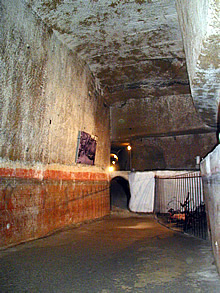
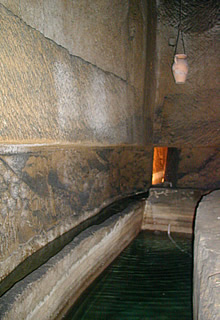
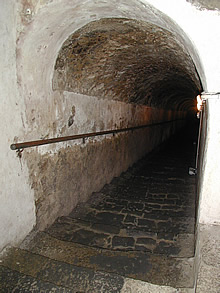
Napoli Sotterranea or Naples Underground (all photos 2005) - we first became aware that there was a system of aqueducts beneath Naples in Robert Harris's excellent book "Pompeii". Seeing them was high on our "to do" list in 2005. They can only be visited in an organised tour - I certainly wouldn't want to go down there on my own, it would be very easy to get lost.
Descending 30 or 40 metres below ground to visit these spaces is quite an experience. The highlight was an extremely narrow, perhaps 50cm wide, passage, roughly hacked from the stone and lit only with candles. It was pitch black in places between candles and you just had to carry on with faith - not for the claustrophobic! This led to a huge, atmospherically lit, water-filled cistern.
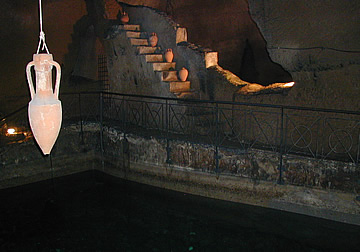
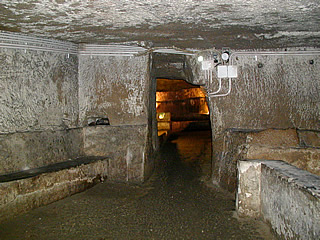
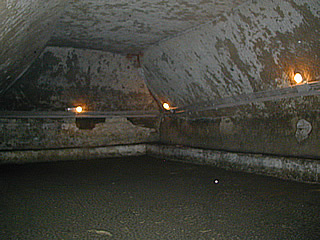
First we visited the remains of a Roman theatre which is also underground. It is reached by entering one of the houses in the Centro Storico and moving aside a bed in a corner of one of the rooms. Here there is a trap door in the floor which, when opened, reveals a long flight of steps going down into the earth. The theatre was very large and it is said that Nero himself performed in his own operas here. The remains aren't particularly inspiring, though. However, this certainly couldn't be said of the underground water transport and storage systems - the cisterns and aqueducts - that we then went on to see.
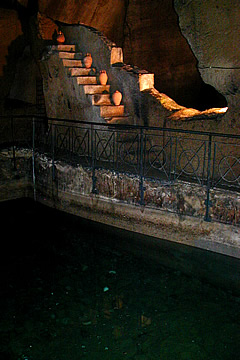
The Greeks quarried into the ground for tufa blocks with which to build the city - building over the very quarries which they had created. Later the Romans continued to dig, but their purpose was solely to do with providing the city with a reliable water supply. Hence they carved huge cisterns and long aqueducts. The system was further enlarged in the 17th century to meet the needs of the growing city, but was closed in 1884 because of a cholera epidemic.
With an area of around 10,000 square metres below the old city, each house had its own well from which to draw water from the cisterns.
During the Second World War this huge underground area sheltered Neapolitans from the bombing.
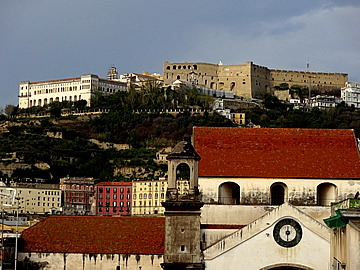
On top of the Vomero hill the current star-shaped fortress dates from the sixteenth century, but a building of some sort had already stood on this site for almost 300 years.
There are tremendous views from its walls as well as a former Carthusian monastery Certosa di San Martino alongside, which is now a museum with nativities and artworks - quite a bit to see.
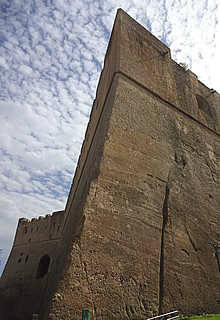
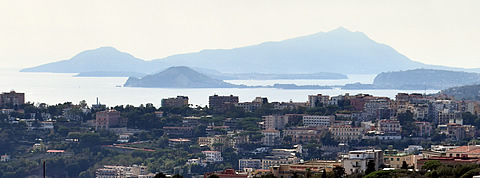

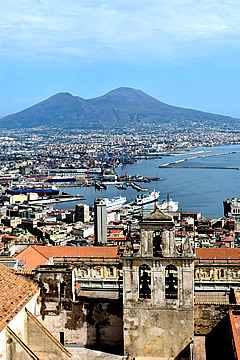
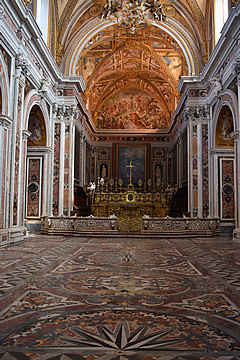
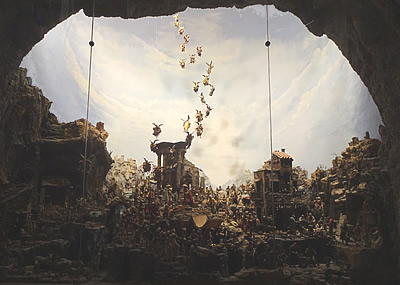
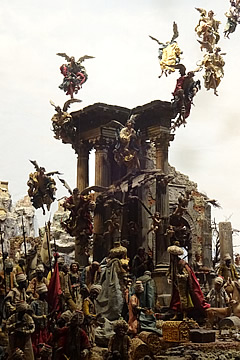
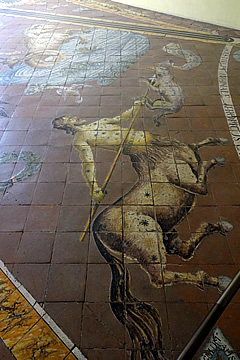
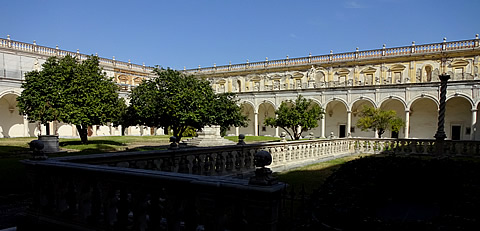
In the large sunlit cloisters once more we find reminders of mortality in the shape of skulls mounted on a balustrade.
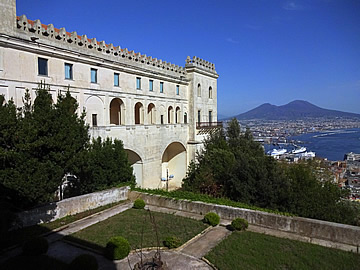
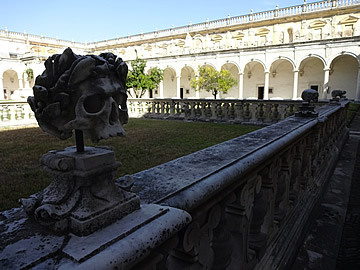
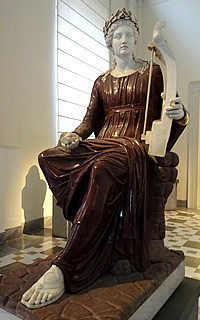
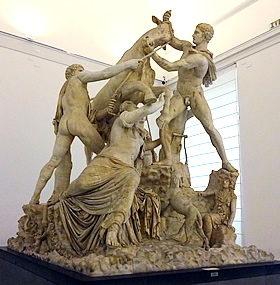
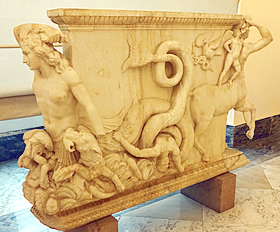
The museum has a great deal to see including some magnificent sculpture - the Farnese Bull is probably the most famous piece, but in 2005 we managed to miss it! In 2017 we made a beeline for it and it really is a magnificent work.
The Bull is part of the Farnese Collection which forms the core of the museum along with many wonderful artefacts ferom Pompeii and Herculaneum.
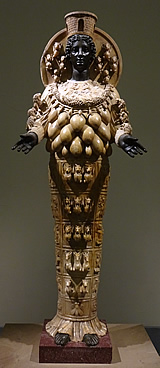
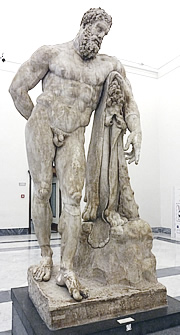
The Romans had great respect and admiration for Greek sculpture and many of the works are copies of Greek originals.
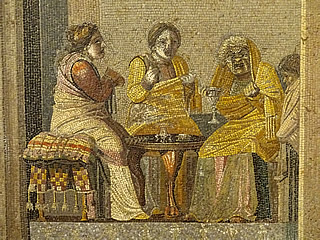
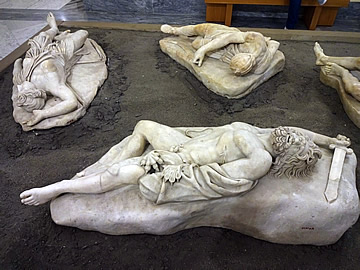
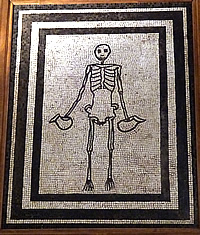

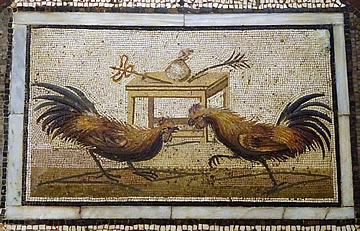
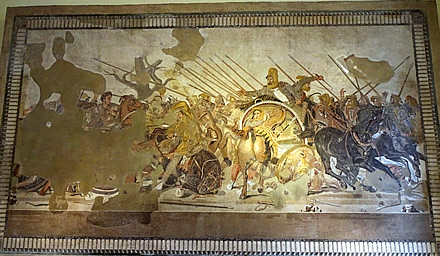
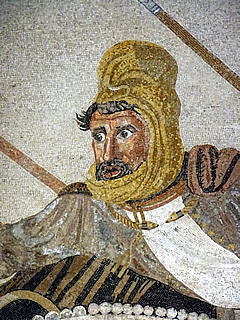
The Alexander mosaic is thought to be a late 2nd century B.C. copy of either an earlier painting contemporary with the time of Alexander, or a late 4th century B.C. fresco. It was found in the House of the Faun in Pompeii in 1831 together with many other fabulous mosaics now displayed here in the museum. Originally it would have been on a floor.
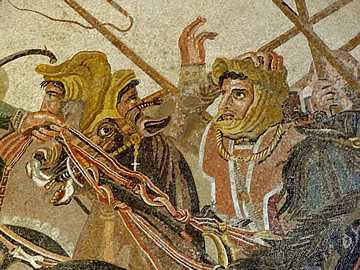


The mosaic depicts Alexander and Darius III of Persia in battle around 330B.C. Alexander rides his famous horse, Bucephalus, and Darius is in a chariot.
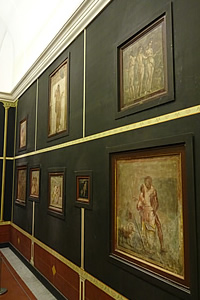
There's lots of erotica from the archaeological sites - the Romans had a very celebratory and humorous attitude to this aspect of life.
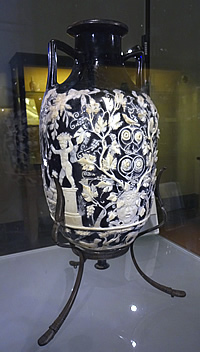
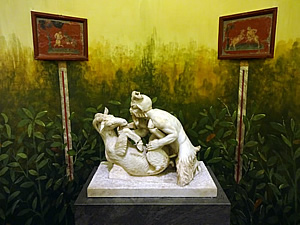
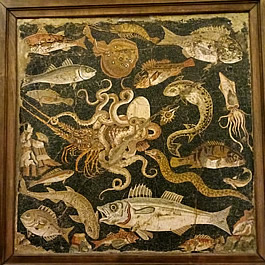
One of the most beautiful pieces is a blue and white cameo glass vase, in the shape of a wine amphora, with scenes of cupids gathering grapes.
It is truly amazing that this fragile piece, over two thousand years old, has survived.